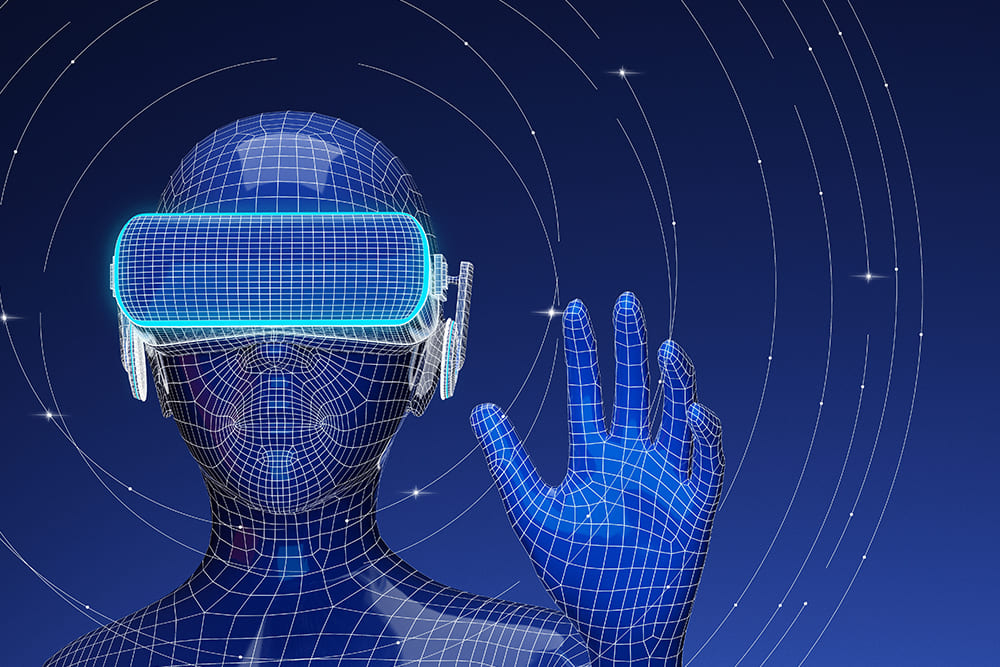Education in the Metaverse: Reimagining the Future of Learning


Education in the Metaverse: Reimagining the Future of Learning
The educational sector is one of many areas where the metaverse can make a significant impact. With this new technology, education is expected to take on new heights of excitement and efficiency.
- Definition of the Metaverse in Education
- Advantages of Using Metaverse as a Teaching Tool
- Possibilities in Metaverse-Based Teaching
- Benefits of Virtual Worlds for Learning
- Negative Aspects of Virtual Classes
- Future Potential Applications of the Metaverse
- Applications of Metaverse in Edtech
- Create a Metaverse for Your Students with EvaCodes
- Conclusion
Definition of the Metaverse in Education
With the help of the metaverse, students can participate in online courses from anywhere while still receiving the benefits of a traditional classroom setting. Both academic institutions and IT firms are making strides to make virtual environments more interactive, immersive, and conversational to decrease reliance on physical proximity.
Advantages of Using Metaverse as a Teaching Tool
When it comes to lifelong learning, technology has become an essential tool. Education has rapidly evolved, with virtual cloud-based classrooms and webinars giving way to self-paced learning environments, micro-learning, and now augmented reality (AR) and virtual reality (VR), enabling immersive learning experiences. Students can gain a deeper comprehension of previously unfamiliar material, take closer looks at various items (such as the structure of an atom or a section of the human body), and have more fun in the classroom as a result.
Concepts of adaptive education and a dynamic course load
Interactively explaining an idea in a virtual setting often makes it much easier to grasp a new concept. With the help of a virtual 3D classroom, metaverse enables learners to get a visual representation of any process, from planning to launch to final assembly to technological considerations, which can be experienced firsthand.
Putting the fun back into learning
Education in the metaverse can help students concentrate better. For example, students can learn about the traits and environments of different regions by traveling to such places in the metaverse. The students can then design their own personalized learning environments, with avatars inspired by local culture.
Enhancing classroom interaction
Social engagement in simulated working environments is an effective method for developing collaboration and problem-solving abilities. Using a role-playing strategy that places students in recognizable scenarios, such as the creation of avatars, can facilitate teaching a complex subject with relative ease. The metaverse enables the development of hypothetical worlds that mirror actual ones.
Quickly accessing desired data
Internet-enabled methods make it simple to disseminate information to more people. It is cost-effective since once a course has been developed, it may be used by many students. Individualized learning plans will be presented in a clear and concise fashion through enhanced search engine results and more effective socially collaborative technologies.


Expert Metaverse Development
We build decentralized applications and smart contracts for a variety of uses.
Possibilities in Metaverse-Based Teaching
While the rise of metaverse platforms has already affected some domains, such as online retail and live events like concerts, there are still a number of areas where it has yet to make an impact.
Improved diversity, equity, and inclusion
Investment in metaverse education solutions is high partly because of the potential for delivering diversity, equity, and inclusion (DEI) advantages. In the case of face-to-face instruction, educators are urged to prioritize individualized opportunities for all students. Tools like the metaverse can provide for students who need extra help in ways that are less taxing on teachers’ time and materials while catering to each student’s interests. As a result, many students will have a more even playing field.
Relatable to modern students (digital natives)
In an effort to make education more engaging, several metaverse solutions focus heavily on incorporating gaming elements into the classroom. The popularity of video games, innovative uses of educational technology, social networking, and other types of digital entertainment among today’s youth makes this trend understandable.
Combine with mirror worlds for immersive learning
One of the main advantages of the metaverse is that it provides an easy entrance into a mirror world, which may be used to immerse pupils in a collaborative learning environment. A mirror universe is precisely what it sounds like: a reflection of our own. Mirror worlds, digital maps that attempt to recreate the physical world as faithfully as possible, are useful for providing virtual platforms for social interaction.
Benefits of Virtual Worlds for Learning
Time and location for learners to participate in class
Traditionally, courses occur in a physical classroom at predetermined times during the school day, or students can only participate when a teacher starts a meeting on a video-conferencing platform. In the metaverse, time and virtual space do not matter so long as one has access to a fast enough network or a powerful enough computer.
Learner identity
Students use their true names while signing up for classes, whether they’re taking them in person or virtually. They have more freedom in how they display themselves through their avatars. They log in to classes as their personalized, lifelike, and reactive digital selves. As they take charge of their virtual selves in the metaverse, they gain a profound feeling of agency.
Learners’ social interactions
Learners can experience issues like apathy and emotional deficit on video conferencing platforms because it is difficult for them to get together and connect with peers and teachers face-to-face through the screen. In the metaverse, students can interact with both avatar teachers and classmates as well as intelligent non-player characters (NPCs) in the roles of both teachers and peers.
Learning scene
Real classroom scenes exist in both traditional face-to-face classrooms and modern online video-conferencing classrooms. The COVID-19 era has presented significant difficulties in recreating authentic educational settings like classrooms and laboratories. On the other hand, different learning scenes can be replicated in the learning environment.
Learning resource
The visual and distributed nature of learning materials in a metaverse-based curriculum facilitates collaboration and sharing of knowledge. Consider a class on Earth; in the past, students would have learned about the planet through a lecture with a printed textbook and a demonstration with physical objects like a terrestrial globe and a map; however, with the help of AR, students would have access to completely new learning resources.
Learning activity
At first look, the learning activities appear to be contextualized in these vibrant and colorful learning sceneries, which can significantly improve students’ cognitive representation through interaction with virtual objects in 3D perspectives. The ability to easily collaborate with peers in real time in virtual forms like meetups, conferences, idea sharing, group discussions, presentation panels, or debates, rather than just staring at a grid of screen content, is another unique aspect of learning activity in the metaverse.
Learning interaction
Unlike in a traditional classroom setting, where students interact primarily through verbal exchanges, students using video conferencing tools typically rely on visual and aural communication. Learners’ interactions aided by interaction technologies like sensors, BCI, VR, AR, or XR, are typically embodied and multi-sensory, stimulating and motivating a wide range of learners’ senses (e.g., vision, auditory, or kinesthesia).
Learning objective
While in or out of the classroom, students can use the metaverse to participate in a variety of learning activities (such as group projects, creative learning, or inquiry-based learning) that could improve their ability to apply, analyze, evaluate, or generate new knowledge.
Learning assessment
Due to the difficulty of capturing student performance and obtaining student learning data, traditional classrooms generally employ summative assessments based on learning outcomes. If students’ performance is based solely on test scores, it will have unfavorable consequences, such as increased educational disparity. Thanks to these tools, teachers in the metaverse have access to formative and summative data from learners’ learning logs and analyses. Significantly, it goes beyond the constraints of conventional evaluation by focusing on a student’s development rather than their performance.
Negative Aspects of Virtual Classes
Even as the metaverse opens up new vistas for remote learning, various risks are associated with using it for school. This section will focus on four major difficulties that the metaverse poses to academic pursuits.
Technology and equipment
Teleporting students and instructors into the metaverse requires a well-designed and reasonably priced smart wearable gadget. Hardware price matters, but most people can’t afford what’s out there right now. It’s essential to consider the metaverse’s user interface requirements, whether it’s universal availability, high fidelity, visualization, immersion, or support for several senses. The current gear and software are far from the technological standard needed to widely implement the metaverse in the classroom.
Privacy and data security
Whether in the real world or in a virtual one, protecting users’ personal information is a top priority. More specific information about users, such as their faces, bodies (heart rate, blood pressure, diseases, etc.), transactions, consumption habits, and the like can be collected in the metaverse because data is the fundamental form of government there. Furthermore, due to a higher level of online anonymity, it is easier for learners with limited social experience to be exposed to criminal activities. Learners’ everyday lives could be severely disrupted, and their privacy could be violated.
Ethics and morality
Users from all around the world can access the metaverse thanks to its great degree of freedom. New issues could lead to cross-national, cross-racial, cross-religious, and cross-gender ethical obstacles, such as the variety of ideas and worldviews, simulated experiments, data theft, racial problems, religious disputes, bullying, violence, and so on. Ethical and legal training for students is also crucial for becoming good metaverse citizens.
Addiction
Learners are more likely to immerse themselves in the metaverse world due to its high immersion and its affect on reality as provided by the sensor and virtual technologies. Addiction might potentially harm young learners’ physical and mental health because they lack the self-discipline and self-control to avoid it. Students will need instructors’ and parents’ advice to strike a healthy balance between time spent in and away from the metaverse and to avoid getting a false sense of spiritual pleasure from the technologies available.
Identity and social interaction
Users may become confused about their “real-me identity” and “virtual-me identity” as the line between the two worlds blurs. Furthermore, if students place a high value on the social connection established between their avatars and NPCs in the virtual worlds, they may develop emotional and social barriers that make it challenging for them to form similar relationships in the real world; at the same time, NPC teachers may pose a threat to the status of human educators.
Future Potential Applications of the Metaverse
Blended learning
The metaverse provides enormous chances for educators and students to participate in educational settings using wearable devices, even from different physical locations. In the metaverse, we may easily actualize the potential for simultaneous or asynchronous in-person and remote learning. Students can use avatars in a variety of learning scenarios (such as a lecture, solo work, group panel, or collaborative work) and have pleasant interactions with both real and virtual instructors and classmates.
Virtual experiment learning
A virtual laboratory, complete with experiment instruments projected in 3D to the virtual world, can be reproduced with the help of modeling and rendering technologies, allowing users to execute a wide range of virtual experiments. This allows students to participate in a wide range of interactive virtual experiments in real time.
Language learning
There are numerous pros to using the metaverse for language study. Learning a new language at first requires a structured classroom environment, especially for lessons focusing on hearing and speaking. One speaking lesson’s goal, for instance, would be to learn how to ask for flight information in an airport with the help of a native speaker. Taking an entire class of students to the airport or having the airport officials visit the school is often unrealistic in the real world. However, in the metaverse, students can participate in various virtual learning activities in a simulated airport setting, including role-plays and practice with avatar partners or with a predetermined intelligent NPC airport personnel or air hostess.
Competency-based education
Rather than focusing on broad academic courses as the basis for curriculum development, competency-based education (CBE) is a prominent paradigm for educational reform in the Vocational Education and Training (VET) sector. VET typically relies on a framework alternating between theoretical study and hands-on experience.
The metaverse has been proposed as a possible answer to CBE. The technology has two main benefits: first, it allows teachers and students to easily transition between classroom and professional settings, allowing students to pick up both broad and specific knowledge through remote observation; second, it can permanently place students in a professional training environment, allowing them to hone their craft with real-world clients whenever and wherever they like.
Inclusive education
The term “children with special needs” is most commonly used to refer to kids who fall into the category of being disabled, but it can also encompass kids who have been neglected, mistreated, or diagnosed with mental illness. However, most teachers find it difficult for their special education children to integrate with typically developing classmates. With its unique characteristics, the metaverse makes sense as a virtual learning space where kids with special needs can study alongside their typically developing peers.
Applications of Metaverse in Edtech
Virtual classrooms
The metaverse empowers the creation of cutting-edge 3D virtual courses, where students are not limited by time, place, or other institutional constraints thanks to advancements in modeling and rendering technologies like AR/VR and XR.
Students and teachers alike can attend classes in the metaverse, where they can create their own avatars and interact with one another, participate in a variety of activities in breakout rooms, play educational games, and virtually visit libraries, marine worlds, historical sites, and more.
Virtual campus activities
Students can participate in extracurricular activities like athletics and the arts in a completely online environment thanks to the metaverse. Like regular university events, students can participate in enjoyable groups like music or math clubs. They can explore their digital college without leaving the house.
Practical learning
By merging or exchanging the concepts, the metaverse facilitates a greater grasp of the ideas at play across disciplinary boundaries. To provide a more well-rounded education, math formulas, for instance, can supplement physics concepts.
Events with prominent figures
It can be very advantageous to have well-known people (such as scientists, doctors, and athletes) visit schools and have students engage with and learn from them. The metaverse can serve as a setting for online learning, meetings, seminars, and classes.
Create a Metaverse for Your Students with EvaCodes
The impact of a metaverse on education is relatable based on the traits and benefits listed above. Without a metaverse, it will be impossible for educators to advance and remain relevant. This can only be achieved with the help of an innovative and expert team of metaverse development companies like EvaCodes.
Our expertise lies in developing distributed platforms with improved interoperability. With our expertise in blockchain technology, we have provided innovative solutions to different industries like banking, education, and more. We have a full suite of cutting-edge technology and can offer an effective metaverse to your school.
Conclusion
Technology has the potential to improve or even revolutionize the educational process if it is used appropriately and with forethought. It could also help students learn more quickly, create a welcoming community, and provide them the chance to hone their craft in risk-free settings.
Get in touch with our skilled metaverse development team if you’re interested in creating your own education solution in the metaverse. We can plan for a seamless transfer to the metaverse, create a functional economy, and build a solid foundation for your metaverse solution.
Written by Vitaliy Basiuk
CEO & Founder at EvaCodes | Blockchain Enthusiast | Providing software development solutions in the blockchain industry





